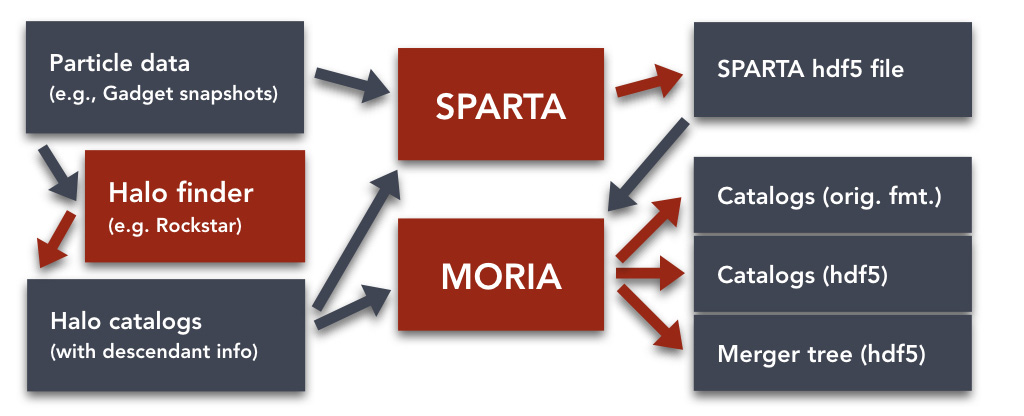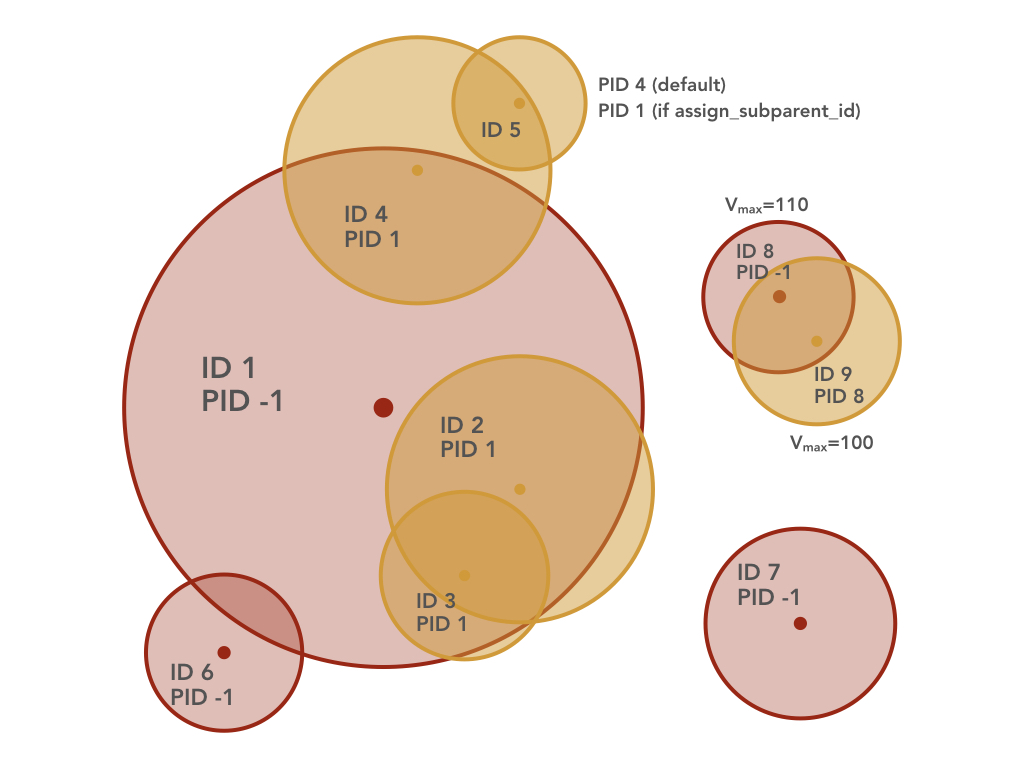Creating halo catalogs with MORIA¶
MORIA is an extension of SPARTA that post-processes output files to create user-defined halo catalogs. The name refers to sacred, publicly owned olive trees in ancient Greece, hinting at MORIA’s dealing with merger trees.
Basics
SPARTA stores its results in a single HDF5 file on a per-halo basis, where halos are defined as in the original, input halo catalog. For many applications, however, we wish to create an altered halo catalog, for example, one containing splashback radii and masses. The purpose of MORIA is to create such catalogs in post-processing, by combining the input catalogs with SPARTA output:

There are a number of reasons why MORIA is a separate tool and why it is run in post-processing, most importantly:
SPARTA can take hours to run on many cores, whereas MORIA typically runs quickly and on one process only.
The output from SPARTA can be used for many different purposes, and be used in many different halo catalogs. MORIA allows the user to easily create such catalogs without re-running SPARTA.
MORIA is entirely configured at run-time, meaning it does not need to be re-compiled for different operations in the way SPARTA does.
MORIA is, however, written in pure C in order to deal with very large catalog files. Some of the most important features are:
MORIA works snapshot by snapshot, the user can choose which redshifts halo catalogs should be created for.
MORIA tries to improve the completeness of catalogs, for example, by approximating SPARTA results such as splashback radii where they could not be computed by SPARTA.
An important part of creating the catalogs is to compute host-sub relations for a variety of user-defined halo radius definitions, including spherical overdensity and splashback radii.
MORIA can output both a native HDF5 catalog format as well as the format of the input halo finder.
MORIA can output a HDF5-based tree format where all halos and snapshots are combined into one file.
How are host-subhalo relations computed?
One of the main tasks of MORIA is to compute host-subhalo relations for a number of definitions requested by the user. The following schematic highlights a few situations:

Each assignment is output in a parent_id_<def> field. A parent ID (PID) of -1 indicates
that the halo is a host. If a halo is the sub of a subhalo but outside other, larger halos, it
is still counted as a subhalo (halo 5 above). In this case, we can assign it the ID of its direct
parent (the default behavior) or the ID of the host’s host (if hostsub_assign_subparent_id is
set). If a halo is a sub of a subhalo but inside the host’s host, it is always assigned the primary
host’s ID (1 in the case of halo 3 above). In Rockstar, these options are distinguished by the
id and upid fields, in MORIA we always assign the equivalent of upid.
The figure also illustrates a case where the smaller halo (according to the radius definition in
question) is host to a larger subhalo (IDs 8 and 9). The reason for this assignment is that
the smaller halo has the larger mass in the definition used to order the halos (order_def),
in this example \(V_{\rm max}\).
To establish host-sub relations, each halo must have some estimate of a radius for each definition, which causes trouble in cases where no such radius is available. MORIA solves such cases as follows:
For splashback radii, a radius is always computed, reconstructed, or guessed (see above).
For SO radii from the catalog, the radius can be zero, for example in cases where the density never reaches a particular threshold. We keep the zero radius, meaning that such halos are deemed too small to host subhalos.
For halos where the
SO_TOO_SMALLstatus was set by SPARTA, we similarly set a radius to zero as the real radius is too small to be resolved.For halos where the
SO_TOO_LARGEstatus was set by SPARTA, the situation is more complicated. Most of those halos are subhalos where the profile included the host halo, and thus never went down to the desired density threshold. This leaves us with no real information about the halo’s “true” size. We thus again set the radius to zero, as the subhalo is likely close to the host’s center anyway.Depending on the chosen cut threshold for halos, some halos may not be found in the SPARTA file. This indicates a poor matching of the lower mass cutoff in SPARTA and MORIA, since the MORIA cutoff should ideally be more conservative. However, when setting a threshold that is not simply as mass such as Vmax, some halos may not have had sufficient mass to be output by SPARTA even though they make a reasonably conservative Vmax cut. Again, we set their radius to zero; this is not physical, and the user is encouraged to always check that the vast majority of halos in a MORIA output catalog should have been found by SPARTA (see Compiling and Running MORIA).
In practice, as long as not too many halos are missing in SPARTA, the impact on the overall statistics of the host-sub assignments should be small.
One final note: the host-sub assignments in MORIA use all halos in the catalog, regardless of the mass (or other) cut the user has imposed. Thus, it is possible that some halos are subhalos of halos that are not written to the final catalog (or tree) files. This situation can be avoided if the ordering and cut quantities are the same (see Configuring MORIA).
Contents
